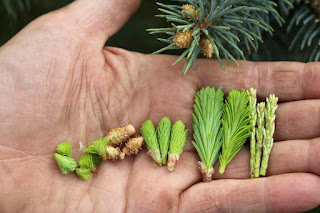On the Farm and in the Kitchen
I know spring is right around the corner but I have something to say about winter and foraging before the season is over. For several months, I have been thinking about what else I could take to the Farmers Market to sell. I enjoy making the jams and jellies. I also enjoy growing sunflowers and I am thinking of expanding the flowers BUT I keep thinking about something else to offer and it has to fit in with everything else I am already doing! I posted a blog about Apple Cider Vinegar in November. I started thinking more about doing flavored vinegars. I started "googling" flavored vinegars. I found a post about pine needle vinegar and it said that it was similar to balsamic vinegar. I LOVE balsamic vinegar so I just had to give this a try and this led me down a rabbit hole of conifer needle goodies...
For the vinegar, I started collecting conifer needles around the farm. We have several types of conifer trees around our home. I found this article to help with identification:
How to Identify Conifer Trees: Pine, Fir, Spruce, Juniper & More It was still pretty challenging to identify everything. One big "take home" message for me is to stay away from Yew trees (they have red berries) and can be poisonous. Luckily, we don't have any Yews. I think we mostly have pine, spruce, hemlock, and junipers...but I could be wrong.
Making a pine needle vinegar is super easy. Here’s how herbalist Susan Weed does it (from the article Pine Keeps You Fine): “I preserve all the vitamins found in fresh pine needles by soaking them in apple cider vinegar for six weeks. I fill a wide-mouthed jar with pine needles and pour room-temperature, pasteurized apple cider vinegar over them until they are completely covered. A plastic (or non-metal) lid and a label with the name of the plant and the date completes the preparation. I call this tasty vinegar “home-made balsamic vinegar” and you will be surprised at how much it tastes like the store bought stuff —’Only better,’ say many, with a smile” (Weed, 2008, para. 4).
Here is my jar of pine needle vinegar. I was surprised to see it fermenting away so there must be a good amount of sugar in the pine needles? Side note for this next winter: You can also infuse vodka or gin with pine needles the same way and use to make winter cocktails!
Some uses for pine needle vinegar:
Pour a spoonful or more on beans and grains as a condiment
Use it in salad dressings
Add it to cooked greens
Season stir-fries with it
Look for soups that are vinegar friendly, like borscht
Put a big spoonful in a glass of water and drink it
Use it as a hair rinse to add shine to your hair!
Something else you can make with pine needles is tea. Just pour boiling hot water over the needles and let them steep. I did make some tea with a couple of different needles but I have to say that I just did not really enjoy it that much. I will just stick to my own peppermint herbs for a tea.
I even found a cookie recipe that uses pine needles: Pine Needle Sugar Cookies
Here is an article with 30 Uses for Pine Needles...everything from syrup and pastries to beard balm! If you infuse a carrier oil with pine needles, you can use it to make a lip balm. I am seriously thinking of doing this...just put pine needles in a jar and then fill it with oil and let it sit for 6 weeks. Voila! You have a conifer infused oil to use in making salves and balms.
Some benefits of pine needles include: lifting your mood, dispelling worry and fatigue, relieving the pain of sore muscles, relieving headaches, soothing frazzled nerves, and relieving skin irritations. I did see a recipe for a Headache Balm made with the infused oil.
The great thing about conifer needles is that they are not seasonal! You can go out and pick them any time of year. BUT...Did you know that you can eat the bright new growth at the end of the branches in the spring? They are called "tips" and spruce tips seem to be the most popular. They have a bright, citrus flavor that works well in both savory and sweet dishes. Almost all conifer tips are edible, and the only exception is yew trees. Pine and fir tips have their own unique taste, and as an added bonus, all conifer tips have medicinal properties. I had never really paid attention to tips before but the bush right by our front door always has some bright green tips and now I see it as a sign of warmer weather!
 |
Conifer Tips ~ From left to right:
Hemlock Tips, Spruce Tips, Young Fir Tips, Older Fir Tips and Pine Shoots
Taken from Foraging Spruce Tips |
I just love finding new uses for something that we have lots of and there are a good amount of conifer trees around our property. I am hoping to make a gallons of apple cider vinegar (from the 50 apple trees we have) this fall so I can make lots of fun, flavored vinegars next year! I just need to get some bottles and I should be able to get started. I am going to put some pics of bottles in a Facebook post later this week and would love some input!
Have an eggcellent day!
~Denise





You will always amaze this city girl. Who knew I could make vinegar with pine needles, etc. Keep up the good work. I do so enjoy following you.
ReplyDeleteI did not know this either until I started "googling". Thank God for the information learned through the internet!
Delete